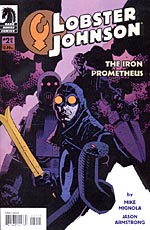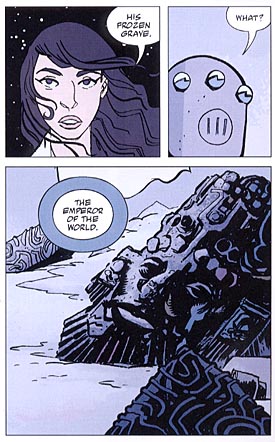 Written by Mike Mignola
Written by Mike Mignola
Art by Jason Armstrong
32 pages, color
Published by Dark Horse
Maybe it has to do with Mike Mignola having more free time on his hands now that he’s not drawing new issues of Hellboy, but it certainly feels like there’s been a small explosion of Hellboy material as of lately. The B.P.R.D. spin-off series is chugging steadily along, the Hellboy: Darkness Calls mini-series is coming to a conclusion, the new Hellboy: The Troll Witch and Others collection just hit stores, and if that wasn’t enough now there’s the Lobster Johnson: The Iron Prometheus mini-series, spun out of earlier Hellboy appearances. But is it possible for there to be too much of a good thing?
In 1937, Lobster Johnson is best known for leaving the mark of a lobster claw stamped on the forehead of wrong-doers that he has defeated. When an experimental suit is the target of villains trying to channel its energies, Lobster Johnson is drawn into its path. But can even he stop a force so powerful that it destroyed an entire civilization?
 What immediately struck me about Lobster Johnson is that in many ways it’s little more than a merging of Hellboy‘s occult craziness with pulp crime fiction of the 1930s. Aside from that scenery change and slightly different looking villains, one could mistake Lobster Johnson for another Hellboy mini-series. Ancient powers, doom-filled prophecies, mysterious sigils and idols, mustache-twirling villains… is there anything really different between the make-up of the two series? Don’t get me wrong, Mignola is still writing a thoroughly entertaining story (and one where I think he’s successfully upping the proverbial ante with each issue), but it’s hard to differentiate the two. With B.P.R.D. one can make the argument that it’s the difference between a team story and one focused on an individual, but I can’t really see that much of a difference here. Still, the story is entertaining, and Mignola has some nice twists waiting as the story unwinds. It’s not particular memorable, but it’s the sort of fun little story that will certainly entertain the reader immensely as they go through its pages.
What immediately struck me about Lobster Johnson is that in many ways it’s little more than a merging of Hellboy‘s occult craziness with pulp crime fiction of the 1930s. Aside from that scenery change and slightly different looking villains, one could mistake Lobster Johnson for another Hellboy mini-series. Ancient powers, doom-filled prophecies, mysterious sigils and idols, mustache-twirling villains… is there anything really different between the make-up of the two series? Don’t get me wrong, Mignola is still writing a thoroughly entertaining story (and one where I think he’s successfully upping the proverbial ante with each issue), but it’s hard to differentiate the two. With B.P.R.D. one can make the argument that it’s the difference between a team story and one focused on an individual, but I can’t really see that much of a difference here. Still, the story is entertaining, and Mignola has some nice twists waiting as the story unwinds. It’s not particular memorable, but it’s the sort of fun little story that will certainly entertain the reader immensely as they go through its pages.
Jason Armstrong’s art comes across as being very much in the same vein as Mignola’s. From fallen ancient carvings to grimaces on faces, Armstrong’s art made me actually wonder if he’d been drawing off of detailed layouts provided by Mignola. (There’s no sign of that in the credit box, though.) That’s not a bad thing, though, because it provides a visual continuity for fans of Mignola’s who might have followed him over from Hellboy. The look plants Lobster Johnson into the same world as Hellboy quite easily, and Dave Stewart’s colors certainly help in that matter. It’s a very easy comic to follow visually, with Armstrong doing a good job of pulling the reader through the book and keeping the action sequences easy to understand. All in all, an attractive final product.
It’s perhaps unfair to spend so much time comparing the two series, but with so much other similar material also from Mignola hitting shelves at the same time, one can’t help but wonder if waiting a little bit would have been a better idea. Then, perhaps, Lobster Johnson‘s story would stand-out a little more in its own right; right now it just falls into a jumble of similar books with little to differentiate it from its friends. It certainly deserves better, but right now it seems to just be a victim of bad timing.
